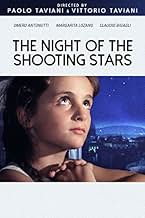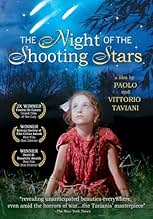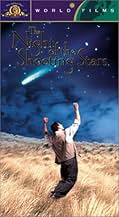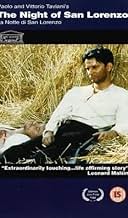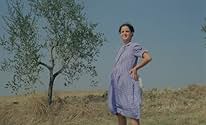VALUTAZIONE IMDb
7,2/10
4897
LA TUA VALUTAZIONE
Nel 1944, gli abitanti di una piccola città italiana sotto il controllo nemico fuggirono dalle loro case per cercare le forze alleate in liberazione.Nel 1944, gli abitanti di una piccola città italiana sotto il controllo nemico fuggirono dalle loro case per cercare le forze alleate in liberazione.Nel 1944, gli abitanti di una piccola città italiana sotto il controllo nemico fuggirono dalle loro case per cercare le forze alleate in liberazione.
- Regia
- Sceneggiatura
- Star
- Premi
- 19 vittorie e 13 candidature totali
Sergi Dagliana
- Olinto
- (as Sergio Dagliana)
Recensioni in evidenza
There are many ways to portrait war, and the Tavianis choose a very circuitous one: By showing it through the eyes of a group of refugees - who, naturally, try to stay away from the fights as much as possible. Many of those refugees are real characters, with little stories of their own, so it's less a film about the actual WW2, but rather about how people react to war as a whole, how it can bring out the best (or worst) in a man and how it upsets everything you took for granted.
One of the nicest things about "La notte di San Lorenzo" is how there's always something lovely or funny to be found - comic or beautiful situations under the direst of circumstances, even if the laughter dies in your throat a few seconds later when violence cruelly rises again. This film celebrates life and humanity itself!
One of the nicest things about "La notte di San Lorenzo" is how there's always something lovely or funny to be found - comic or beautiful situations under the direst of circumstances, even if the laughter dies in your throat a few seconds later when violence cruelly rises again. This film celebrates life and humanity itself!
The Night of the Shooting Stars is the semi-autobiographical recollection by the Taviani Brothers of the night when a group of peasants in a small Tuscan village left their homes that had been mined by the Fascists to look for liberating American soldiers rumored to be on the outskirts. Set on the night of the Feast of St. Lawrence in the closing days of World War II, and enhanced by a haunting score by Nicola Piovani, the film is a tragi-comic glimpse of what the war was like to an impressionable child filtered through years of memory. It is essentially a series of vignettes combining fact, memory, and poetic imagination told in flashback by a mother recalling her days as a 6-year old girl named Cecilia caught in the middle of war.
The film focuses on the nature of a conflict in which life long friends from the same village are often engaged in the struggle on different sides. Especially vivid is a scene involving a battle in a wheat field between the villagers and home grown Fascists, and a heart wrenching confrontation between the partisans and a father with his 15-year old son. There are many other poignant moments as well: a young couple expecting a child, the village priest who is a collaborator, and an elderly couple rekindling a romance started when they were adolescents.
Night of the Shooting Stars pays homage to the tradition of neo-realism, but also includes surrealistic moments such as when the young girl sees the partisans as Greek warriors, while the Fascist who threatens her life falls dead, pierced by multiple spears. Though Night of the Shooting Stars suffers from overacting, its unique approach allows us to see war as a very personal experience with all of its sadness and cruelty. It was also gratifying to see Americans being held in high esteem, an experience we haven't enjoyed much of recently.
The film focuses on the nature of a conflict in which life long friends from the same village are often engaged in the struggle on different sides. Especially vivid is a scene involving a battle in a wheat field between the villagers and home grown Fascists, and a heart wrenching confrontation between the partisans and a father with his 15-year old son. There are many other poignant moments as well: a young couple expecting a child, the village priest who is a collaborator, and an elderly couple rekindling a romance started when they were adolescents.
Night of the Shooting Stars pays homage to the tradition of neo-realism, but also includes surrealistic moments such as when the young girl sees the partisans as Greek warriors, while the Fascist who threatens her life falls dead, pierced by multiple spears. Though Night of the Shooting Stars suffers from overacting, its unique approach allows us to see war as a very personal experience with all of its sadness and cruelty. It was also gratifying to see Americans being held in high esteem, an experience we haven't enjoyed much of recently.
I recently spent two weeks near San Miniato (home town of the directors and setting for the film), so part of this film's charm for me was to revisit the beautiful Tuscan countryside. But it is also a moving portrayal of a painful moment in Italian history, as the advancing Allies, the retreating Germans, the Fascist Blackshirts, the anti-Fascist partisans, and deserters from the Italian Army all converge on a small hilltop town in Tuscany (called "San Martino" in the film). Meanwhile, ordinary civilians just try to survive and keep their dignity. Some of the townspeople accept the Germans' offer of sanctuary with the bishop in the cathedral; others strike out across the countryside to find the Americans. Each group faces the unanticipated consequences of their choices. I have the feeling that many of the actors were non-professionals - entire families appear in the cast list - and the editing & special effects are also kept very simple. (There's a great deal of violence, but almost no cinematic "blood and gore.") But perhaps that's in keeping with the somewhat "naive" perspective that the film strives for - the story is told through the eyes of an eight-year old girl. For a book that focuses on the same region and period, I'd recommend Iris Origo's "War in Val d'Orcia."
Italian films of the late forties and early fifties were usually shot in the same neorealistic style. They showed he horrors of WW2, but also showed the fierce determination of Italians to free themselves from fascist rule. By the late 1950s. Italian cinema had pivoted to screwball romantic comedies and surrealist style of direction like Fellini. Style began to overwhelm Italian cinema and neorealism was soon a memory. This film not only revives some of that old-fashioned Italian neorealism, but also marries it to modern surrealism, in a blend of comedy and horror that one seldom finds in cinema today. It is a film not to be missed by true lovers of, not only Italian cinema, but of all cinema. Don't miss it.
"La notte di San Lorenzo" is from the heydays of the Taviani brothers (the first half of the 80s) but is in my eyes one of their weaker films from this period.
It is situated near the end of the Second World War. The Germans are desperate and a cornered cat makes weird jumps. The inhabitants of a small Italian village decide not to wait for these weird jumps and travel in the direction where they believe the American liberators are.
The journey becomes sort of an odyssey. Old stories are told and hidden secrets are revealed. I was especially touched by the story of the old widow and widower obliged to share a room and confessing their mutual love sixty years after the fact. Gabriel Carcia Marquez could have written it.
The story is told as a bedstory from a mother to her child. When the film ends the child turns out te have been sleeping from the very beginning. So the mother has in fact told the story to herself .... or to us.
It is situated near the end of the Second World War. The Germans are desperate and a cornered cat makes weird jumps. The inhabitants of a small Italian village decide not to wait for these weird jumps and travel in the direction where they believe the American liberators are.
The journey becomes sort of an odyssey. Old stories are told and hidden secrets are revealed. I was especially touched by the story of the old widow and widower obliged to share a room and confessing their mutual love sixty years after the fact. Gabriel Carcia Marquez could have written it.
The story is told as a bedstory from a mother to her child. When the film ends the child turns out te have been sleeping from the very beginning. So the mother has in fact told the story to herself .... or to us.
Lo sapevi?
- QuizThe church scene, where Germans bomb the church full of people, was based on real life events that took place in San Miniato (the birthplace of Paolo Taviani and Vittorio Taviani). However, more than two decades after this movie was made, the case was reopened and it was discovered, that the fatal bomb actually belonged to the American army, and hit the church accidentally.
- BlooperA man, likely Dilvo, raises watermelon to his mouth with both hands, but in the next shot is eating it only with the right hand.
- ConnessioniFeatured in Marcello Mastroianni: mi ricordo, sì, io mi ricordo (1997)
I più visti
Accedi per valutare e creare un elenco di titoli salvati per ottenere consigli personalizzati
- How long is The Night of the Shooting Stars?Powered by Alexa
Dettagli
- Data di uscita
- Paese di origine
- Lingue
- Celebre anche come
- The Night of the Shooting Stars
- Luoghi delle riprese
- Empoli, Tuscany, Italia(church bombing scene on Piazza Farinata degli Uberti)
- Aziende produttrici
- Vedi altri crediti dell’azienda su IMDbPro
Botteghino
- Lordo Stati Uniti e Canada
- 2.257.307 USD
- Fine settimana di apertura Stati Uniti e Canada
- 4414 USD
- 16 ago 2015
- Lordo in tutto il mondo
- 2.257.307 USD
- Tempo di esecuzione1 ora 47 minuti
- Mix di suoni
- Proporzioni
- 1.66 : 1
Contribuisci a questa pagina
Suggerisci una modifica o aggiungi i contenuti mancanti




